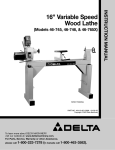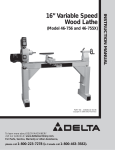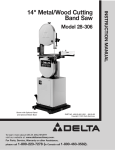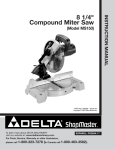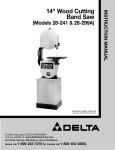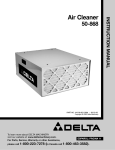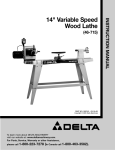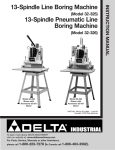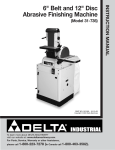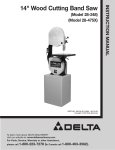Download Delta LA200 Instruction manual
Transcript
(Model LA200) PART NO. 906122 - 06-05-02 Copyright © 2002 Delta Machinery To learn more about DELTA MACHINERY visit our website at: www.deltamachinery.com. For Parts, Service, Warranty or other Assistance, please call ESPAÑOL: PÁGINA 23 1-800-223-7278 (In Canada call 1-800-463-3582). INSTRUCTION MANUAL Midi-Lathe GENERAL SAFETY RULES Woodworking can be dangerous if safe and proper operating procedures are not followed. As with all machinery, there are certain hazards involved with the operation of the product. Using the machine with respect and caution will considerably lessen the possibility of personal injury. However, if normal safety precautions are overlooked or ignored, personal injury to the operator may result. Safety equipment such as guards, push sticks, hold-downs, featherboards, goggles, dust masks and hearing protection can reduce your potential for injury. But even the best guard won’t make up for poor judgment, carelessness or inattention. Always use common sense and exercise caution in the workshop. If a procedure feels dangerous, don’t try it. Figure out an alternative procedure that feels safer. REMEMBER: Your personal safety is your responsibility. This machine was designed for certain applications only. Delta Machinery strongly recommends that this machine not be modified and/or used for any application other than that for which it was designed. If you have any questions relative to a particular application, DO NOT use the machine until you have first contacted Delta to determine if it can or should be performed on the product. Technical Service Manager Delta Machinery 4825 Highway 45 North Jackson, TN 38305 (IN CANADA: 505 SOUTHGATE DRIVE, GUELPH, ONTARIO N1H 6M7) WARNING: FAILURE TO FOLLOW THESE RULES MAY RESULT IN SERIOUS PERSONAL INJURY 1. FOR YOUR OWN SAFETY, READ INSTRUCTION MANUAL BEFORE OPERATING THE TOOL. Learn the tool’s application and limitations as well as the specific hazards peculiar to it. 2. KEEP GUARDS IN PLACE and in working order. 3. ALWAYS WEAR EYE PROTECTION. Wear safety glasses. Everyday eyeglasses only have impact resistant lenses; they are not safety glasses. Also use face or dust mask if cutting operation is dusty. These safety glasses must conform to ANSI Z87.1 requirements. NOTE: Approved glasses have Z87 printed or stamped on them. 4. REMOVE ADJUSTING KEYS AND WRENCHES. Form habit of checking to see that keys and adjusting wrenches are removed from tool before turning it “on”. 5. KEEP WORK AREA CLEAN. Cluttered areas and benches invite accidents. 6. DON’T USE IN DANGEROUS ENVIRONMENT. Don’t use power tools in damp or wet locations, or expose them to rain. Keep work area well-lighted. 7. KEEP CHILDREN AND VISITORS AWAY. All children and visitors should be kept a safe distance from work area. 8. MAKE WORKSHOP CHILDPROOF – with padlocks, master switches, or by removing starter keys. 9. DON’T FORCE TOOL. It will do the job better and be safer at the rate for which it was designed. 10. USE RIGHT TOOL. Don’t force tool or attachment to do a job for which it was not designed. 11. WEAR PROPER APPAREL. No loose clothing, gloves, neckties, rings, bracelets, or other jewelry to get caught in moving parts. Nonslip footwear is recommended. Wear protective hair covering to contain long hair. 12. SECURE WORK. Use clamps or a vise to hold work when practical. It’s safer than using your hand and frees both hands to operate tool. 13. DON’T OVERREACH. Keep proper footing and balance at all times. 14. MAINTAIN TOOLS IN TOP CONDITION. Keep tools sharp and clean for best and safest performance. Follow instructions for lubricating and changing accessories. 15. DISCONNECT TOOLS before servicing and when changing accessories such as blades, bits, cutters, etc. 16. USE RECOMMENDED ACCESSORIES. The use of accessories and attachments not recommended by Delta may cause hazards or risk of injury to persons. 17. REDUCE THE RISK OF UNINTENTIONAL STARTING. Make sure switch is in “OFF” position before plugging in power cord. In the event of a power failure, move switch to the “OFF” position. 18. NEVER STAND ON TOOL. Serious injury could occur if the tool is tipped or if the cutting tool is accidentally contacted. 19. CHECK DAMAGED PARTS. Before further use of the tool, a guard or other part that is damaged should be carefully checked to ensure that it will operate properly and perform its intended function – check for alignment of moving parts, binding of moving parts, breakage of parts, mounting, and any other conditions that may affect its operation. A guard or other part that is damaged should be properly repaired or replaced. 20. DIRECTION OF FEED. Feed work into a blade or cutter against the direction of rotation of the blade or cutter only. 21. NEVER LEAVE TOOL RUNNING UNATTENDED. TURN POWER OFF. Don’t leave tool until it comes to a complete stop. 22. STAY ALERT, WATCH WHAT YOU ARE DOING, AND USE COMMON SENSE WHEN OPERATING A POWER TOOL. DO NOT USE TOOL WHILE TIRED OR UNDER THE INFLUENCE OF DRUGS, ALCOHOL, OR MEDICATION. A moment of inattention while operating power tools may result in serious personal injury. 23. MAKE SURE TOOL IS DISCONNECTED FROM POWER SUPPLY while motor is being mounted, connected or reconnected. 24. THE DUST GENERATED by certain woods and wood products can be injurious to your health. Always operate machinery in well ventilated areas and provide for proper dust removal. Use wood dust collection systems whenever possible. 25. WARNING: SOME DUST CREATED BY POWER SANDING, SAWING, GRINDING, DRILLING, AND OTHER CONSTRUCTION ACTIVITIES contains chemicals known to cause cancer, birth defects or other reproductive harm. Some examples of these chemicals are: · lead from lead-based paints, · crystalline silica from bricks and cement and other masonry products, and · arsenic and chromium from chemically-treated lumber. Your risk from these exposures varies, depending on how often you do this type of work. To reduce your exposure to these chemicals: work in a well ventilated area, and work with approved safety equipment, such as those dust masks that are specially designed to filter out microscopic particles. 2 ADDITIONAL SAFETY RULES FOR WOOD LATHES WARNING: FAILURE TO FOLLOW THESE RULES MAY RESULT IN SERIOUS PERSONAL INJURY. 1. DO NOT OPERATE THIS MACHINE UNTIL it is assembled and installed according to the instructions. 2. OBTAIN ADVICE from your supervisor, instructor, or another qualified person if you are not familiar with the operation of this machine. 3. FOLLOW ALL WIRING CODES and recommended electrical connections. 4. ROUGH CUT THE WORKPIECE as close as possible to the finished shape before installing it on the faceplate. 5. EXAMINE THE WORKPIECE FOR FLAWS and test glue joints before mounting the workpiece on machine. DO NOT mount a split workpiece or one containing a knot. 6. SECURELY FASTEN THE WORKPIECE to the faceplate prior to faceplate turning. Use the appropriate size faceplate to properly support the workpiece. Do not let the screw fasteners interfere with the turning tool at the finished dimension of the workpiece. 7. NEVER DRIVE THE WORKPIECE into the drive center while the drive center is in the headstock. Set the drive center into the workpiece with a soft mallet prior to installing it into the headstock. 8. SNUG THE TAILSTOCK CENTER against the workpiece and lock it when turning between centers. Lubricate the tailstock center if it is not a ball bearing center. 9. PROPERLY ADJUST THE TOOL REST HEIGHT. 10. ADJUST THE TOOL REST so it is as close to the workpiece as possible. 11. TIGHTEN ALL CLAMP LOCKING HANDLES before operating. 12. ROTATE THE WORKPIECE BY HAND to check clearance before turning the machine “ON”. 13. CLEAR THE LATHE BED OF ALL OBJECTS (tools, scraps of wood, etc.) before turning the machine “ON”. 14. EXAMINE THE SET-UP CAREFULLY before turning the machine “ON”. 15. STAND CLEAR, AND KEEP ALL OBSERVERS AND PASSERSBY clear of rotating path of workpiece to avoid injury from flying debris. 16. USE THE LOWEST SPEED when starting a new workpiece. NEVER EXCEED recommended speeds. 17. NEVER ADJUST THE TOOL REST while the workpiece is turning. 18. NEVER LOOSEN THE TAILSTOCK SPINDLE or the tailstock while workpiece is turning. 19. MOVE THE CUTTING TOOL INTO THE WORKPIECE SLOWLY, and cut small amounts when roughing. 20. REMOVE THE TOOL REST before sanding or polishing. 21. NEVER PERFORM LAYOUT, assembly, or set-up work on the table/work area when the machine is running. 22. TURN THE MACHINE “OFF” AND DISCONNECT THE MACHINE from the power source before installing or removing accessories, before adjusting or changing set-ups, or when making repairs. 23. TURN THE MACHINE “OFF”, disconnect the machine from the power source, and clean the table/work area before leaving the machine. LOCK THE SWITCH IN THE “OFF” POSITION to prevent unauthorized use. 24. ADDITIONAL INFORMATION regarding the safe and proper operation of this machine is available from the Power Tool Institute, 1300 Summer Avenue, Cleveland, OH 44115-2851. Information is also available from the National Safety Council, 1121 Spring Lake Drive, Itasca, IL 60143-3201. Please refer to the American National Standards Institute ANSI 01.1 Safety Requirements for Woodworking Machines and the U.S. Department of Labor OSHA 1910.213 Regulations. SAVE THESE INSTRUCTIONS. Refer to them often and use them to instruct others. 3 CONNECTING TOOL TO POWER SOURCE POWER CONNECTIONS A separate electrical circuit should be used for your tools. This circuit should not be less than #12 wire and should be protected with a 20 Amp time lag fuse. If an extension cord is used, use only 3-wire extension cords which have 3-prong grounding type plugs and 3-hole receptacles which accept the tool’s plug. Before connecting the motor to the power line, make sure the switch is in the “OFF” position and be sure that the electric current is of the same characteristics as indicated on the tool. All line connections should make good contact. Running on low voltage will damage the motor. WARNING: DO NOT EXPOSE THE TOOL TO RAIN OR OPERATE THE TOOL IN DAMP LOCATIONS. MOTOR SPECIFICATIONS Your tool is wired for 110-120 volt, 60 HZ alternating current. Before connecting the tool to the power source, make sure the switch is in the “OFF” position. GROUNDING INSTRUCTIONS WARNING: THIS TOOL MUST BE GROUNDED WHILE IN USE TO PROTECT THE OPERATOR FROM ELECTRIC SHOCK. 2. Grounded, cord-connected tools intended for use on a supply circuit having a nominal rating less than 150 volts: This tool is intended for use on a circuit that has an outlet that looks like the one illustrated in Fig. A. The tool has a grounding plug that looks like the plug illustrated in Fig. A.. A temporary adapter, which looks like the adapter illustrated in Fig. B, may be used to connect this plug to a 2-hole receptacle as shown in Fig. B if a properly grounded outlet is not available. The temporary adapter should be used only until a properly grounded outlet can be installed by a qualified electrician. The green-colored rigid ear, lug, and the like, extending from the adapter must be connected to a permanent ground such as a properly grounded outlet box. Whenever the adapter is used, it must be held in place with a metal screw. 1. All grounded, cord-connected tools: In the event of a malfunction or breakdown, grounding provides a path of least resistance for electric current to reduce the risk of electric shock. This tool is equipped with an electric cord having an equipment-grounding conductor and a grounding plug. The plug must be plugged into a matching outlet that is properly installed and grounded in accordance with all local codes and ordinances. Do not modify the plug provided - if it will not fit the outlet, have the proper outlet installed by a qualified electrician. Improper connection of the equipment-grounding conductor can result in risk of electric shock. The conductor with insulation having an outer surface that is green with or without yellow stripes is the equipment-grounding conductor. If repair or replacement of the electric cord or plug is necessary, do not connect the equipment-grounding conductor to a live terminal. NOTE: In Canada, the use of a temporary adapter is not permitted by the Canadian Electric Code. Check with a qualified electrician or service personnel if the grounding instructions are not completely understood, or if in doubt as to whether the tool is properly grounded. WARNING: IN ALL CASES, MAKE CERTAIN THE RECEPTACLE IN QUESTION IS PROPERLY GROUNDED. IF YOU ARE NOT SURE, HAVE A QUALIFIED ELECTRICIAN CHECK THE RECEPTACLE. Use only 3-wire extension cords that have 3-prong grounding type plugs and 3-hole receptacles that accept the tool’s plug, as shown in Fig. A. Repair or replace damaged or worn cord immediately. HOLES GROUNDED OUTLET BOX GROUNDED OUTLET BOX GROUNDING MEANS CURRENT CARRYING PRONGS ADAPTER GROUNDING BLADE IS LONGEST OF THE 3 BLADES HOLES Fig. A Fig. B 4 EXTENSION CORDS MINIMUM GAUGE EXTENSION CORD RECOMMENDED SIZES FOR USE WITH STATIONARY ELECTRIC TOOLS Ampere Rating Use proper extension cords. Make sure your extension cord is in good condition and is a 3-wire extension cord which has a 3-prong grounding type plug and a 3-hole receptacle which will accept the tool’s plug. When using an extension cord, be sure to use one heavy enough to carry the current of the tool. An undersized cord will cause a drop in line voltage, resulting in loss of power and overheating. Fig. C shows the correct gauge to use depending on the cord length. If in doubt, use the next heavier gauge. The smaller the gauge number, the heavier the cord. Volts Total Length of Cord in Feet Gauge of Extension Cord 0-6 0-6 0-6 0-6 120 120 120 120 up to 25 25-50 50-100 100-150 18 AWG 16 AWG 16 AWG 14 AWG 6-10 6-10 6-10 6-10 120 120 120 120 up to 25 25-50 50-100 100-150 18 AWG 16 AWG 14 AWG 12 AWG 10-12 10-12 10-12 10-12 120 120 120 120 up to 25 25-50 50-100 100-150 16 AWG 16 AWG 14 AWG 12 AWG 12-16 12-16 12-16 120 120 120 up to 25 25-50 14 AWG 12 AWG GREATER THAN 50 FEET NOT RECOMMENDED Fig. C OPERATING INSTRUCTIONS FOREWORD Delta Model LA200 is a compact and stable wood lathe with a powerful 1/2 HP, 1725 rpm motor. This lathe will turn objects up to 10" in diameter over the bed and 6" in diameter over the tool rest base with a maximum distance between centers of 37" with the optional bed extension. UNPACKING AND CLEANING This machine is shipped complete in one container. Carefully remove the contents from the shipping container. Remove the protective coating from the lathe bed and all unpainted parts. This coating may be removed with a soft cloth moistened with kerosene (do not use acetone, gasoline or lacquer thinner). After cleaning, cover the lathe bed with a good quality paste wax. NOTICE: THE MANUAL COVER PHOTO ILLUSTRATES THE CURRENT PRODUCTION MODEL. ALL OTHER ILLUSTRATIONS ARE REPRESENTATIVE ONLY AND MAY NOT DEPICT THE ACTUAL COLOR, LABELING OR ACCESSORIES AND MAY BE INTENDED TO ILLUSTRATE TECHNIQUE ONLY. 5 CARTON CONTENTS 10 1 9 6 5 2 8 7 3 4 1. Lathe 2. Tailstock 3. Live Center 4. Knockout Bar 5. Tool Rest Base 6. Spur Center 7. Tool Rest 8. Spacer 9. Face Plate 10. Spanner Wrench Fig. 1 ASSEMBLY B C D D A Fig. 3 Fig. 2 ATTACHING ON/OFF SWITCH To prevent damage to the on/off switch, the lathe is shipped with the switch bracket detached from the rear of the headstock. Attach the switch bracket in the upright position. Align two holes in switch bracket (A) Fig. 2 with the two holes (B) at the rear of the headstock (C), and attach the switch bracket (A) to the machine with two pan head screws (D) and lockwashers (Fig. 3). B B D A C Fig. 4 A Fig. 5 ATTACHING TOOL REST TO THE LATHE BED 1. Loosen locking lever (A) Fig. 4 and slide tool rest base (B) into the channel of lathe bed (C). NOTE: If the tool rest base will not slide easily inside the channel of the lathe bed, turn the tool rest base over and loosen locknut (D) Fig. 4, located at the underside of the tool rest base. Tighten locking lever (A) Fig. 5 to clamp the tool rest base (B) securely on the lathe bed. 2. IMPORTANT: If clamping action on the tool rest base (B) Fig. 5 is too tight or too loose on the lathe bed, remove the base and turn nut (D) Fig. 6 clockwise to tighten clamping action, or counterclockwise to loosen clamping action. Attach the tool rest base on the lathe bed. 6 D E F Fig. 6 Fig. 7 3. Loosen locking lever (E) Fig. 7, and insert tool rest (F) into the tool rest base. NOTE: The height of the tool rest can be adjusted up or down as needed. Tighten locking lever (E). B D A C Fig. 8 Fig. 9 ATTACHING TAILSTOCK TO THE LATHE BED 1. Loosen locking lever (A) Fig. 9, and slide tailstock assembly (B) in the channel (C) Fig. 8 of the lathe bed. 2. IMPORTANT: If clamping action on the tailstock (B) Fig. 9 is too tight or too loose on the lathe bed, remove the tailstock and turn nut (D) Fig. 8 clockwise to tighten clamping action, or counterclockwise to loosen clamping action. Attach the tailstock on the lathe bed and tighten locking lever (A) Fig. 9. A B Fig. 10 ATTACHING HEADSTOCK SPUR CENTER TO THE LATHE DISCONNECT MACHINE FROM POWER SOURCE. 1. The spur center (A) Fig. 10, supplied with your lathe, is equipped with a No. 2 Morse Tapered shank (B). It will fit snugly into the headstock spindle. NOTE: Before inserting, clean both the shank and the headstock spindle to remove any grease or debris. 7 A 2. Use the knockout bar (C) Fig. 11 through the hole in the opposite end of the spindle to remove the spur center (A) Fig. 11 from the headstock spindle. NOTE: Be careful of the sharp points on the shank spur center. C IMPORTANT: NEVER DRIVE THE WORKPIECE INTO THE SPUR CENTER WHEN IT IS MOUNTED IN THE HEADSTOCK. See the “OPERATIONS” section of this manual. Fig. 11 ATTACHING LIVE CENTER TO THE TAILSTOCK DISCONNECT MACHINE FROM POWER SOURCE. The tailstock live center (A) Fig. 12, supplied with your lathe, is equipped with a No. 2 Morse Taper shank (B) and is inserted into the tailstock spindle (C). To remove the live center (A) Fig. 13 from the tailstock spindle, loosen lock knob (C) and rotate handwheel (D) to move spindle (B) back into the tailstock body. This action will push the live center (A) out of the spindle (B). Use the knockout bar through the hollow tailstock (F) to remove the center point (E). A B C E F A B D C Fig. 12 Fig. 13 ATTACHING FACEPLATE TO THE HEADSTOCK To use the faceplate for inboard turning, mount the faceplate to the headstock spindle in the following manner (shown without workpiece for clarity). 1. DISCONNECT MACHINE FROM POWER SOURCE. 2. Install spacer (A) Fig. 14 on the headstock spindle (B). 3. Thread faceplate (C) Fig. 15 on spindle. Insert knockout bar (D) into hole in spindle to keep it from turning, and tighten faceplate (C) with supplied wrench (B) on flats. A D B B C C Fig. 15 Fig. 14 8 FASTENING LATHE TO SUPPORTING SURFACE The wood lathe must be fastened to a supporting surface. Four mounting holes (three of which are shown (A) Fig. 16 are provided in the base of the lathe. A A Fig. 16 OPERATING CONTROLS AND ADJUSTMENTS STARTING AND STOPPING THE LATHE The on/off switch (A) Fig. 17 is located on the bracket (B) attached earlier to the rear of the headstock. To turn the switch “ON”, move the switch (A) up to the “ON” position. To turn the switch “OFF”, move the toggle switch (A) down to the “OFF” position. LOCKING SWITCH IN THE “OFF” POSITION IMPORTANT: When the machine is not in use, the switch should be locked in the “OFF” position to prevent unauthorized use. To lock, grasp the toggle (C) Fig. 18, and pull it out of the switch (A).When the safety toggle (C) Fig. 18 is removed, the switch will not operate. However, should the safety toggle be removed while the wood lathe is operating, the switch can be turned “OFF” once, but cannot be restarted without inserting the safety toggle (C) back into the switch. C A A B Fig. 18 Fig. 17 SPINDLE SPEEDS Depending on the position of the belt on the motor and spindle pulleys, the wood lathe is capable of providing speeds of 500, 800, 1250, 1800, 2650, and 3700 RPM. CHANGING SPINDLE SPEEDS The wood lathe features a six-step motor pulley and spindle pulley to provide the different spindle speeds for particular wood turning applications. To change speeds: 1. Disconnect machine from power source. 9 2. Open access doors (A) and (B) Fig. 19 to gain access to motor pulley (C) Figs. 20 and 20A, and spindle pulley (D) Figs. 20 and 21. 3. Loosen locking lever (E) Fig. 20 to relieve tension on the motor pulley. Raise lever (F) Fig. 20, and tighten locking lever (E) to enable the drive belt to be moved on the pulleys. IMPORTANT: A speed and belt position chart (G) Figs. 20 and 21 is located on the inside of the access door (A) to help position the belt (H) Fig. 21 correctly on the pulleys. 4. While holding lever (F) Fig. 20, loosen locking lever (E).to release tension on the motor. Lower the motor. (NOTE: The weight of the motor will provide proper tension on the drive belt.) Tighten locking lever (E). G D A A C B E F Fig. 20 Fig. 19 D C G Fig. 20A Fig. 21 ADJUSTING TOOL REST For most applications, the tool rest should be positioned as close as possible to the work and approximately 1/8” above the work centerline. 1. To position the tool rest base (A) Fig. 22 along the lathe bed, loosen locking lever (B), slide the tool rest base to the desired position, and tighten lever (B). 2. To adjust the height of the tool rest (C) Fig. 22, loosen lever (D), raise or lower tool rest and tighten lever (D). 3. The clamping device on the tool rest base can be adjusted by turning the tool rest support (A) Fig. 23 over and adjusting nut (E) clockwise to tighten or counterclockwise to loosen the clamping action. A C E A D B Fig. 23 Fig. 22 10 ADJUSTING TAILSTOCK 1. To slide the tailstock along lathe bed, loosen locking lever (A) Fig. 24, slide tailstock (B) into position, and tighten lever (A). The clamping device for the tailstock has been set prior to shipping. However, if the clamping action needs adjustment, remove the tailstock and tighten (or loosen) nut (C) Fig. 25 on the bottom of the tailstock. Reattach the tailstock to the lathe bed. B A C Fig. 24 Fig. 25 E 2. To move the ram (D) Fig. 26, in or out, loosen locking lever (E) and turn handwheel (F). Tighten lever (E) after adjusting ram (D). NOTE: Total ram (D) travel ranges from 0 to 1-1/2". F D Fig. 26 REPLACING DRIVE BELT When it becomes necessary to replace the drive belt: 1. Disconnect machine from power source. 2. Open the two access doors (A) Fig. 27. 3. Hold the handle (B) Fig. 27, and loosen the locking lever (C). Pull up on the handle (B) to remove tension on the drive belt and then tighten locking lever (C). 4. Loosen the two set screws (D) Figs. 27 and 28, and remove the handwheel (E). 5. Loosen the set screw (G) Fig. 28 on the spindle pulley (H). D A G D E D E D B A H C Fig. 28 Fig. 27 11 6. Use a soft-tipped mallet (J) Fig. 29 to carefully tap the spindle shaft (K) thru the bearing. Tap it far enough to move the spindle shaft to the right to remove the spindle pulley (H), and spindle shaft (K), (Fig. 30). IMPORTANT: Be careful not to drop the metal key (M) Fig. 30 into the hub of the spindle pulley (H). 7. Remove the drive belt (A) Fig. 31 from the motor pulley (B). 8. Replace the drive belt and the spindle assembly in reverse order. Apply proper tension to the drive belt. Refer to section “CHANGING SPINDLE SPEEDS”. 9. IMPORTANT: When attaching the spindle and handwheel, make certain that the set screws in the spindle pulley are tightened against the flat surface of the spindle. Check the spindle pulley to see if it is aligned with the motor pulley. Adjust if necessary. K H M K H L J Fig. 29 Fig. 30 A B Fig. 31 ATTACHING BED EXTENSION The total bed length of the lathe (center to center) can be increased to 37" by purchasing and installing an accessory bed extension. To attach the bed extension to the lathe: 1. Align the two holes in the end of the lathe bed (A) Fig. 32 with the two holes (B in the end of bed extension ) and fasten with two M10 x 40 x 1-1/2" hex head screws, lockwashers, and flat washers (C) using the supplied wrench (D). 2. IMPORTANT: Before tightening screws, use a straight edge (E) Fig. 33 to be certain that the lathe bed (A) is flush with the bed extension (B). This action will allow the tailstock to move freely along both beds. E A D B A C B Fig. 32 Fig. 33 12 The following directions will give the inexperienced operator a beginning point for common lathe operations. Practice on scrap material before attempting serious work. LATHE TOOLS Standard wood turning tools come in several different configurations (Fig. A1). The majority of turnings will require the gouge tool (A) Fig. A1. This round nosed hollow chisel is used for roughing cuts, cove cuts and other operations. The skew chisel (B) is a double-ground flat chisel, with an angled end. This tool is used for smoothing cylinders, for cutting shoulders, beads, veegrooves, etc. The parting tool (C) is a double-ground chisel, used for cutting-off, or for making straight incisions or sizing cuts to any required diameter. The round nose scraper (D) is used for mostly hollowing work, while the square-end scraper is mainly used for the outside of bowls. E C A B HOW TO TURN SPINDLES Fig. A1 Working with any material that is attached to the lathe centers is called spindle turning, used for chair and table legs, lamp stems, etc. The turning of spindles can be done with either a scraping or cutting technique. The cutting technique, by virtue of faster wood removal and a cleaner surface, is the preferred method. CENTERING THE WORK Wood stock for any spindle turning should be approximately square, and the ends should be square with the sides. Two common methods of determining the center are shown in Figs. A2 and A3. In Fig. A2, a distance a little more or a little less than one-half the width of the stock is set off from each of the four sides. The small square set off in the center can then be used in marking the true center. The diagonal method, Fig. A3, consists of drawing lines from corner to corner, with the intersection marking the center of the work. Fig. A2 Fig. A3 13 D A After marking each end, mark the true center with a punch awl or dividers (Fig. A4). If the stock is hardwood, the centers should be drilled to a depth of about 1/8”. The spur or live center is then placed against one end of the work and seated by striking with a mallet (Fig. A5). In hardwood, make a starting seat for the spur center by sawing on the diagonal lines, and drilling a small hole at the intersection. After driving the center, hold the center and the work together and fit both immediately to headstock spindle. If you are not using a ball bearing center, the end of work at tailstock center should be oiled. Place the lubricant on the wood either before or after it is put on the lathe. Many turners use beeswax, tallow, or a wax-and-oil mixture as a lubricant. A ball bearing center is ideal because it eliminates lubricating. If the work is to be removed from the lathe before completion, an index mark should be made as a guide for re-centering (Fig. A6). A permanent indexer can be made by grinding off one corner of one of the spurs. Fig. A4 Fig. A5 MOUNTING THE WORK Mount the work by moving the tailstock to a position about 1" or 1-1/2" from the end of the workpiece, and locking it in this position. Advance the tailstock center by turning the feed handle until the center cup makes contact with the work. Do not support the work on the center pin alone. Always have the rim of the center cup imbedded at least 1/8" into the work. Continue to advance the center while slowly rotating the work by hand. After it becomes difficult to turn the work, slack off on the feed about one-quarter turn and lock the tailstock spindle. Fig. A6 TOOL REST POSITION Mount the tool rest in place about 1/8" away from the work and 1/8" above the work centerline (Fig. A7.) This position may be varied to suit the work and the operator. Place a guide mark on the tool rest shank as an aid to quick and accurate resetting. Fig. A7 14 ROUGHING A CYLINDER The large gouge is used in the first turning operation by smoothing the sharp corners of the work. Run the lathe at low speed and hold the gouge in the manner shown in Fig. A8. The cut starts about 2 inches from the tailstock end and continues from this point to the end of the tailstock. Make the second pass beginning about 2" or 3" to the left of the first cut. Advance again toward the tailstock, and merge with the previous cut. Toward the end of the live center, roll the gouge in the opposite direction (Fig. A9) to carry the final cut off the live center end of the work. The roughing cut should not be carried out with one continuous movement, because this would tear long slivers from the corners of the work. Neither should the cut be started directly at the end of the stock for the same reason. The cut can be safely carried from the center of the stock toward and off either end once the first roughing cuts have been made. Fig. A8 The position of the gouge involves two or three important angles. (1) The tool may be advanced along the work either from right to left or from left to right. Left to right (from headstock to tailstock) is preferred since this action throws chips clear of the operator. (2) The gouge is rolled over slightly in the same direction it is advancing. (3) The tool is held well up on the work, with the bevel or grind tangent to the revolving surface (Fig. A10). This position will give a clean shearing cut. When pushed straight into the work (Fig. A10), the gouge has a scraping action, (normally a poor practice in spindle turning). The roughing cut is continued until the work approaches 1/8" of the required diameter. Once a cylindrical form has been obtained, the turning speed can be moved to the second or third speed setting. NOTE: Continue to move the tool rest inward toward the work piece to keep the safe distance between the two. Fig. A9 Fig. A10 POSITION OF HANDS While turning, the hand that holds the tool handle should be in a natural position. This hand provides the leverage for the tool by either moving in toward the chisel or moving out. The position of the tool rest hand is more a matter of individual preference, rather than a “set” or “proper” position. However, a palm-up grip (Fig. A11) is generally considered best. In this position, the first finger acts as a guide, sliding along the tool rest as the cut is made. The alternate position is a palm-down grip (Fig. A12). In this position, the heel of the hand or the little finger serves as a guide. The palm-down position is solid and positive – excellent for roughing or heavy cutting. Most beginners start with the palm-down grip, switching later to the palm-up position for better manipulation of the chisel. Fig. A11 Fig. A12 15 SMOOTHING A CYLINDER To smooth a cylinder, use a large skew chisel. This requires practice, but experience with this tool is very important. Place the cutting point near the center of chisel and high on the work (Fig. A13). Sometimes, in striving for a certain position in relation to the work, the beginner will often overlook this all-important point. Raising the handle will increase the depth of cut while lowering the handle, of course, does the opposite. As with the gouge, the skew can be advanced in either direction. The center of the skew toward the heel does the actual cutting. The back portion of the grind or bevel supports the tool, while the handle-hand controls the depth of cut by rocking the chisel on this pivot point. Because of this, keep the skew bevel perfectly flat. Fig. A13 USING THE PARTING TOOL The parting tool is perhaps the easiest turning chisel to handle. Simply push this scraping tool into the work (Fig. A14). A somewhat better cutting action is obtained if the handle is held low. This tool is, in many cases, held with one hand while the other hand holds the calipers in the cutting groove. When parting tool cuts are deep, a clearance cut should be made alongside the first cut (Fig. A15) to prevent burning the tool point. Fig. A14 Fig. A15 SQUARING AN END The parting tool can be used to quickly square an end. Since the parting tool is a rough cutter, the cut can then be smoothed by using the skew. However, the whole operation can be done with the skew. In using the skew, make your first cut a nicking cut with the toe of the skew (Fig. A16). A deep cut here could burn the chisel, so a clearance cut is made by inclining the skew away from the first cut and pushing the tool into the work. This procedure of side cut and clearance cut is continued as often as needed. NOTE: While the skew can be pushed into the wood in any direction, the cutting edge itself must be inclined a little away from this plane .If the full cutting edge of skew bears against the cut surface, the tool will have a tendency to run. See Fig. A17 for the proper way to make the cut. Push the chisel straight into the work, and incline the cutting edge away from the cut surface. Use only the extreme end of the toe for this cut. This important principle in skew handling will be used repeatedly in making shoulders, beads and vee cuts. Fig. A16 Fig. A17 16 CUTTING A SHOULDER Use the parting tool first to reduce the wood to within 1/16” of the required shoulder and diameter (Fig. A18). Clean the waste stock out with the gouge (Fig. A19), then use the skew for the actual cutting of the shoulder (Fig. A20), which is a duplication of squaring an end. The skew then makes the horizontal cut, but in a different manner from plain cylinder work. If the shoulder is long, use the ordinary skew position for the outer portion of the cut. At the angle between the horizontal and vertical cuts, the heel of the chisel moves into a position tangent between the skew and the cylinder (Fig. A21). In this position, raise the handle of the chisel slightly to allow it to cut while the tool moves along the rest. Use a very light cut to produce smooth work. The heel of the skew can be used for making the entire cut, if desired, but the cut, whether in this position or any other position, should not be picked up directly at the end of the stock. Horizontal cuts started directly from the end of the work will have a tendency to bite into the wood, often ruining the entire piece. Always run off the end and not into it. Where a very short shoulder makes this impossible, use the skew in a flat scraping position. If the cutting technique is used, engage only with the heel of skew in a very light cut. Fig. 49 Fig. A18 Fig. A19 Fig. A20 Fig. A21 CUTTING SMALL BEADS Fig. A22 Beads can be scraped or cut. Using the spear chisel is the easiest method of scraping, and works to best advantage on beads separated by parting tool cuts (Fig. A22). Scraping is slower than cutting and is not as clean, but it has the advantage of protecting the work from long gashes. Cutting beads quickly and accurately with the small skew is one of the most difficult lathe operations. Various working methods can be used . The first cut is a vertical incision at the point where the two curved surfaces will eventually come together. Make this cut with either heel or toe of skew. Fig. A23 shows the use of the toe. Place the skew at right angles to the work . The chisel is flat on its side at the start, and is evenly rotated through the successive stages of the cut (Figs. A24, A25, and A26). At the same time, the chisel is pulled slightly backward to maintain the cutting point. The entire cut is made with the heel of chisel. The opposite side of the bead is cut in the same manner, one cut serving to produce the full shape in each instance. This action produces beads that are beautifully smooth and polished, and the technique is well worth mastering. 17 Fig. A23 Fig. A24 Fig. A25 Fig. A26 VEE GROOVES Cutting the vee groove demands much the same technique as the bead, except the skew is hinged straight into the work without rotation (Fig. A27). Only one-half of the vee is made at a time, and one, two, or more cuts may be needed on each side to obtain the desired shape. As in all cutting with the skew, the bevel next to the cut must be used as a fulcrum. Be careful not to allow full edge of the chisel to catch and cause a run. Vee grooves can also be made with the toe of the skew, in the same manner as squaring an end. Fig. A27 LONG CUTS Long cuts are usually either convex or straight-tapered surfaces. With a convex surface, the method used in making the finishing cut is shown in Fig. A28. The gouge is turned on the tool rest so that it will be inclined in the direction that it will move. The grind is tangent to the work, and the center point of the cutting edge is the contact point with the wood. As the cut progresses toward and around the end of the curve, the handle is gradually raised and swiveled to the right (Fig. A29) in order to maintain the tangency between the grind and the surface being cut . Fig. A28 Fig. A29 Fig. A30 Figs. A30 and A31 show the cutting of a long taper with a skew. The operation differs from smoothing a cylinder only at the start of the cut. The starting cut should be made with the heel (Fig. A30) to prevent the tool from digging into the work. As the tool moves down the work, the chisel can be pulled back to allow the center point of the cutting edge to cut. However, the full taper can be made with the heel. Be careful not to cut too deeply at the center of the taper. The direction of cutting is always downhill. Fig. A31 COVE CUTS Second to forming a perfect bead, the cove or concave cut is the most difficult to master. This cut is made with the gouge, where the size of the tool depends on the size of the cut. Push the gouge directly into the work to remove the surplus stock (Fig. A32). Fig. A32 18 The gouge is placed on edge on the tool rest so that the grind of the chisel forms an approximate right angle with the work (Fig. A33). The chisel contacts the work at the center of the cutting edge. Hold the tool so that the centerline of the gouge is pointing directly toward the center of the revolving stock. This starting position is important to prevent the gouge from running along the surface of the work. From the starting position, push the gouge into the revolving stock, and roll the tool on the rest. A triple action takes place here. (1) The chisel will roll to follow the shape of the cut, (2) the handle will drop slightly so that the portion already cut will force the lip of the chisel sideways and, (3) the chisel will be pushed forward so that at the end of the cut, Fig. A34, it will be well up on the work and tangent with the cut surface. Make only one-half of the cut at a time, then reverse the chisel to cut the other half. The occasional turner should make cove cuts with a scraping technique, using either the small gouge or round nose chisel. Fig. A33 SQUARE SECTIONS Fig. A34 Fig. A35 When the turning has a square section, joint the stock before turning. Good centering is essential since any error will show at the shoulder where the round meets the square. Turning of the shoulder from square to round can be done in various ways (See Figs. A35, A36, A37, and A38). If the parting tool is sharp, the nicking cut with skew (Fig. A37) can be omitted. The final trimming operation (Fig. A38) can be done with either the skew, spear chisel, or gouge, and is a scraping operation. While the shoulder can be cut with the same technique used for cutting a bead, the simpler scraping method pictured does clean work and is easier to do. Fig. A36 Fig. A37 Fig. A38 19 FACEPLATE TURNING Mount turnings that cannot be worked between centers on a faceplate. The greater part of this type of turning is done with the faceplate mounting, although there are a number of jobs which require special chucks. All cutting in faceplate work is done by scraping. Any attempt to use a cutting technique on the edge grain of large work will result in a hogging, gouging cut which may jerk the chisel out of the hands of the operator. Use a band saw on all work to roughly cut the turning area slightly oversized to eliminate heavy roughing cuts in turning. MOUNTING WORK TO FACEPLATE Fig. A39 shows direct mounting to the 3" faceplate along with attaching to the backing block. Because of the ease of setting up, use this mounting whenever the work permits. Hold larger pieces in the same way by using the 6" faceplate. When normal screw-fastenings interfere, mount the work on a backing block (Fig. A39). When screws are not permissible at all, glue the work to the backing block by fitting a sheet of paper at the joint to allow later separation without damaging the wood. Some work can be screwed or nailed from the face side into backing block. Mount work less than 3” in diameter on the single screw center (Fig. A40). Fig. A39 Fig. A40 20 NOTES 21 ACCESSORIES A complete line of accessories is available from your Delta Supplier, Porter-Cable • Delta Factory Service Centers, and Delta Authorized Service Stations. Please visit our Web Site www.deltamachinery.com for a catalog or for the name of your nearest supplier. WARNING: Since accessories other than those offered by Delta have not been tested with this product, use of such accessories could be hazardous. For safest operation, only Delta recommended accessories should be used with this product. PARTS, SERVICE OR WARRANTY ASSISTANCE All Delta Machines and accessories are manufactured to high quality standards and are serviced by a network of Porter-Cable • Delta Factory Service Centers and Delta Authorized Service Stations. To obtain additional information regarding your Delta quality product or to obtain parts, service, warranty assistance, or the location of the nearest service outlet, please call 1-800-223-7278 (In Canada call 1-800-463-3582). Two Year Limited Warranty Delta will repair or replace, at its expense and at its option, any Delta machine, machine part, or machine accessory which in normal use has proven to be defective in workmanship or material, provided that the customer returns the product prepaid to a Delta factory service center or authorized service station with proof of purchase of the product within two years and provides Delta with reasonable opportunity to verify the alleged defect by inspection. Delta may require that electric motors be returned prepaid to a motor manufacturer’s authorized station for inspection and repair or replacement. Delta will not be responsible for any asserted defect which has resulted from normal wear, misuse, abuse or repair or alteration made or specifically authorized by anyone other than an authorized Delta service facility or representative. Under no circumstances will Delta be liable for incidental or consequential damages resulting from defective products. This warranty is Delta’s sole warranty and sets forth the customer’s exclusive remedy, with respect to defective products; all other warranties, express or implied, whether of merchantability, fitness for purpose, or otherwise, are expressly disclaimed by Delta. Printed in U.S.A. 22 PORTER-CABLE • DELTA SERVICE CENTERS (CENTROS DE SERVICIO DE PORTER-CABLE • DELTA) Parts and Repair Service for Porter-Cable • Delta Machinery are Available at These Locations (Obtenga Refaccion de Partes o Servicio para su Herramienta en los Siguientes Centros de Porter-Cable • Delta) ARIZONA Tempe 85282 (Phoenix) 2400 West Southern Avenue Suite 105 Phone: (602) 437-1200 Fax: (602) 437-2200 CALIFORNIA Ontario 91761 (Los Angeles) 3949A East Guasti Road Phone: (909) 390-5555 Fax: (909) 390-5554 San Leandro 94577 (Oakland) 3039 Teagarden Street Phone: (510) 357-9762 Fax: (510) 357-7939 COLORADO Arvada 80003 (Denver) 8175 Sheridan Blvd., Unit S Phone: (303) 487-1809 Fax: (303) 487-1868 FLORIDA Davie 33314 (Miami) 4343 South State Rd. 7 (441) Unit #107 Phone: (954) 321-6635 Fax: (954) 321-6638 Tampa 33609 4538 W. Kennedy Boulevard Phone: (813) 877-9585 Fax: (813) 289-7948 GEORGIA Forest Park 30297 (Atlanta) 5442 Frontage Road, Suite 112 Phone: (404) 608-0006 Fax: (404) 608-1123 ILLINOIS Addison 60101 (Chicago) 400 South Rohlwing Rd. Phone: (630) 424-8805 Fax: (630) 424-8895 Woodridge 60517 (Chicago) 2033 West 75th Street Phone: (630) 910-9200 Fax: (630) 910-0360 MARYLAND Elkridge 21075 (Baltimore) 7397-102 Washington Blvd. Phone: (410) 799-9394 Fax: (410) 799-9398 MASSACHUSETTS Braintree 02185 (Boston) 719 Granite Street Phone: (781) 848-9810 Fax: (781) 848-6759 Franklin 02038 (Boston) Franklin Industrial Park 101E Constitution Blvd. Phone: (508) 520-8802 Fax: (508) 528-8089 MICHIGAN Madison Heights 48071 (Detroit) 30475 Stephenson Highway Phone: (248) 597-5000 Fax: (248) 597-5004 MINNESOTA Minneapolis 55429 5522 Lakeland Avenue North Phone: (763) 561-9080 Fax: (763) 561-0653 Cleveland 44125 8001 Sweet Valley Drive Unit #19 Phone: (216) 447-9030 Fax: (216) 447-3097 MISSOURI North Kansas City 64116 1141 Swift Avenue P.O. Box 12393 Phone: (816) 221-2070 Fax: (816) 221-2897 OREGON Portland 97230 4916 NE 122 nd Ave. Phone: (503) 252-0107 Fax: (503) 252-2123 St. Louis 63119 7574 Watson Road Phone: (314) 968-8950 Fax: (314) 968-2790 PENNSYLVANIA Willow Grove 19090 520 North York Road Phone: (215) 658-1430 Fax: (215) 658-1433 NEW YORK Flushing 11365-1595 (N.Y.C.) 175-25 Horace Harding Expwy. Phone: (718) 225-2040 Fax: (718) 423-9619 NORTH CAROLINA Charlotte 28270 9129 Monroe Road, Suite 115 Phone: (704) 841-1176 Fax: (704) 708-4625 OHIO Columbus 43214 4560 Indianola Avenue Phone: (614) 263-0929 Fax: (614) 263-1238 TEXAS Carrollton 75006 (Dallas) 1300 Interstate 35 N, Suite 112 Phone: (972) 446-2996 Fax: (972) 446-8157 Houston 77055 West 10 Business Center 1008 Wirt Road, Suite 120 Phone: (713) 682-0334 Fax: (713) 682-4867 WASHINGTON Auburn 98001(Seattle) 3320 West Valley HWY, North Building D, Suite 111 Phone: (253) 333-8353 Fax: (253) 333-9613 Authorized Service Stations are located in many large cities. Telephone 800-438-2486 or 731-541-6042 for assistance locating one. Parts and accessories for Porter-Cable·Delta products should be obtained by contacting any Porter-Cable·Delta Distributor, Authorized Service Center, or Porter-Cable·Delta Factory Service Center. If you do not have access to any of these, call 800-223-7278 and you will be directed to the nearest Porter-Cable·Delta Factory Service Center. Las Estaciones de Servicio Autorizadas están ubicadas en muchas grandes ciudades. Llame al 800-438-2486 ó al 731-541-6042 para obtener asistencia a fin de localizar una. Las piezas y los accesorios para los productos Porter-Cable·Delta deben obtenerse poniéndose en contacto con cualquier distribuidor Porter-Cable·Delta, Centro de Servicio Autorizado o Centro de Servicio de Fábrica Porter-Cable·Delta. Si no tiene acceso a ninguna de estas opciones, llame al 800-223-7278 y le dirigirán al Centro de Servicio de Fábrica Porter-Cable·Delta más cercano. CANADIAN PORTER-CABLE • DELTA SERVICE CENTERS ALBERTA Bay 6, 2520-23rd St. N.E. Calgary, Alberta T2E 8L2 Phone: (403) 735-6166 Fax: (403) 735-6144 BRITISH COLUMBIA 8520 Baxter Place Burnaby, B.C. V5A 4T8 Phone: (604) 420-0102 Fax: (604) 420-3522 MANITOBA 1699 Dublin Avenue Winnipeg, Manitoba R3H 0H2 Phone: (204) 633-9259 Fax: (204) 632-1976 ONTARIO 505 Southgate Drive Guelph, Ontario N1H 6M7 Phone: (519) 836-2840 Fax: (519) 767-4131 QUÉBEC 1515 ave. St-Jean Baptiste, Québec, Québec G2E 5E2 Phone: (418) 877-7112 Fax: (418) 877-7123 1447, Begin St-Laurent, (Montréal), Québec H4R 1V8 Phone: (514) 336-8772 Fax: (514) 336-3505 The following are trademarks of PORTER-CABLE·DELTA (Las siguientes son marcas registradas de PORTER-CABLE S.A.): Auto-Set®, BAMMER®, B.O.S.S.®, Builder’s Saw®, Contractor’s Saw®, Contractor’s Saw II™, Delta®, DELTACRAFT®, DELTAGRAM™, Delta Series 2000™, DURATRONIC™, Emc²™, FLEX®, Flying Chips™, FRAME SAW®, Homecraft®, INNOVATION THAT WORKS®, Jet-Lock®, JETSTREAM®, ‘kickstand®, LASERLOC®, MICRO-SET®, Micro-Set®, Midi Lathe™, MORTEN™, NETWORK™, OMNIJIG®, POCKET CUTTER®, PORTABAND®, PORTA-PLANE®, PORTER-CABLE®&(design), PORTER-CABLE®PROFESSIONAL POWER TOOLS, Posi-Matic®, Q-3®&(design), QUICKSAND®&(design), QUICKSET™, QUICKSET II®, QUICKSET PLUS™, RIPTIDE™&(design), SAFE GUARD II®, SAFE-LOC®, Sanding Center®, SANDTRAP®&(design), SAW BOSS®, Sawbuck™, Sidekick®, SPEED-BLOC®, SPEEDMATIC®, SPEEDTRONIC®, STAIR EASE®, The American Woodshop®&(design), The Lumber Company®&(design), THE PROFESSIONAL EDGE®, THE PROFESSIONAL SELECT®, THINLINE™, TIGER®, TIGER CUB®, TIGER SAW®, TORQBUSTER®, TORQ-BUSTER®, TRU-MATCH™, TWIN-LITE®, UNIGUARD®, Unifence®, UNIFEEDER™, Unihead®, Uniplane™, Unirip®, Unisaw®, Univise®, Versa-Feeder®, VERSA-PLANE® , WHISPER SERIES®, WOODWORKER’S CHOICE™. Trademarks noted with ™ and ® are registered in the United States Patent and Trademark Office and may also be registered in other countries. Las Marcas Registradas con el signo de ™ y ® son registradas por la Oficina de Registros y Patentes de los Estados Unidos y también pueden estar registradas en otros países. Printed in U.S.A.























